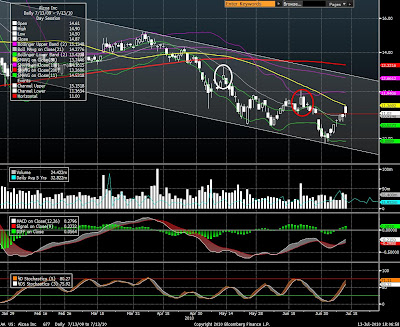



--- Original Sender: KEVIN O'DOWD, STIFEL NICOLAUS & CO ---
----- Original Message -----
From: KEVIN O'DOWD (STIFEL NICOLAUS & CO)
At: 7/13 14:37:39
Great read from Julian Brigden at Credit Agricole...
It's not hard to believe that the correlation between NFP and initial claims has been over 75% over the last 27 years. However, that's what made the massive divergence we'd seen since December so odd. NFP was exploding higher implying claims in the 300K range and yet they remained depressingly flat at 450k. Well on the 2nd the headline NFP number plunged from +433k to -125k and in one month we re-established the relationship (jpg 1) with claims. The timing of the drop, which coincided with the end of census jobs, seemed to explain the reason
divergence although as I pointed out at the time it's a little odd we'd never seen these type of divergences in 1990 or 2000 i.e. other census years.
This massive one month drop didn't worry the market unduly at the time because we were braced for a fall in the headline and were focused instead on the private sector job creation. However, it's this headline no. that most interests me when it comes to retail sales. The reason is simply that I follow a very simple rule when I look at American consumers 'if they have it, they spend it'. Indeed, I think its fair to assume that census workers who this year were heavily drawn from the ranks of the unemployed or students almost certainly have the highest marginal propensity to consume amongst any workers. So bottom line I think we are going to see the fall in jobs materially impact retail sales especially, as the correlation between YoY retail sales growth and
NFP since 1993 is 82% as you can see below. What I particularly like about this chart is that as NFP headline has recovered retail sales have followed tick for tick driving the 5yr correlation to just under 92%. So now NFP has dropped so hard how far could retail sales fall?
Well the chart (jpg2) suggests if we see retail sales follow the same precipitous one month drop of NFP, the YoY rate should drop from last months 6.9% to ZERO. Last June the index of retail sales was 343.1 vs. last month's 362.52 so zero YoY would mean that the monthly rate, expected to print -0.3% on Wednesday would in fact print -5.4%. Now that frankly seems like an inconceivable no. as it would be the worst number we've seen since the series started in 93. However, I have to think that even if we make up the divergence over a couple of months something like -2% tomorrow would cause people to fundamentally question the recovery. Personally, I think all we are doing is remove a lot of the noise created in the data by the census jobs and we should see retail sales drop back to the levels suggested by claims (jpg3) and possibly even the ABC consumer buying climate question (jpg3). Unfortunately, that should cause people to question the recovery!
In terms of trades I believe this would trigger full scale risk off! On that basis I'd suggest taking a look at my 7 longer term risk off trades, which updated for the latest data suggest:
1) 30yr fair value is 3.3%
2) S&P = 875 and is 18% overvalued
3) $/KRW = 1400 and is 16% undervalued
4) $/MXN = 14.25 ie 11% undervalued
5) NZD TWI 112.00 using CEERNZD index ie 8.5% overvalued
6) $/ZAR = 10.00 this is a favourite as it's 30% undervalued. Also
now the World Cup is over flows should abate and the domestic economy is
already weak and the central bank is cutting
7) BMW stock to 25 Euro's from today's 41+...PS you could do a
basket of auto stocks


















